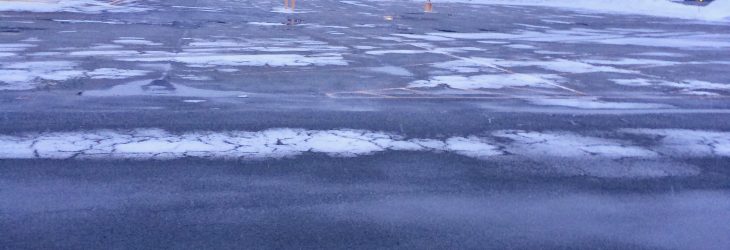During the winter months, property owners and managers must take extra precautions. While the season’s snow and ice may create beautiful scenery, they also can cause extremely dangerous conditions. Property owners have a responsibility to effectively remove snow and ice from sidewalks and parking lots. Failure to do so can not only result in fines, it can also lead to expensive slip-and-fall lawsuits. Plowing and shoveling alone cannot prevent slippery conditions. Anti-icing and de-icing practices are essential to protect yourself and pedestrians. Follow these tips for keeping parking lots and sidewalks clear of ice.
Take Anti-Icing Action
Proactive measures are key when it comes to ice. Apply salt to sidewalks, parking lots and road BEFORE the storm to prevent snow and ice from compacting on surfaces. This anti-icing technique is both economical and ecological. When you anti-ice, typically less or no salt may be needed after the storm. Anti-icing is a quick treatment that can be effective for up to several days depending upon weather conditions. Your snow removal contractor will know the best products to apply and when to apply them.
Consider Your De-Icing Options
De-icing is the most common form of ice removal. It involves applying a de-icing material on top of existing snow or ice to break up the bond between the elements and pavement. This ice removal procedure works best when used in conjunction with anti-icing techniques. While de-icing products eliminate slippery surfaces, they can damage plants and grass, as well as harm pets. So, it is important to choose the product that best works with your landscaping AND ice removal needs. Here are the popular choices:
- Sodium Chloride. Probably the least expensive de-icing product, sodium chloride – also called rock salt – works best in temperatures above 25 degrees. Sodium chloride can be hard on grass and shrubs and leach into the soil.
- Calcium Chloride. Less harmful than sodium chloride, calcium chloride works well in temperatures below zero. It is a bit more expensive, but you don’t have to use as much product. Calcium chloride can leave a slippery residue that can be harmful to pet’s feet, as well as carpet and tile.
- Calcium Magnesium Acetate. Approximately ten times more expensive than sodium chloride, calcium magnesium acetate is a great salt-free, biodegradable option that won’t harm the environment.
- Urea. Although primarily used as a fertilizer, urea is also an effective de-icer. It is less likely to damage vegetation, but it can burn lawn and plants and contaminate runoff water.
Your snow removal contractor can help you select the best ways to remove snow and ice from sidewalks and parking lots taking into account the surrounding landscape.
Curti’s Landscaping, Inc. is the premier choice for snow and ice removal in Bergen County NJ and Rockland County NY.
Call to learn more about our snow plowing, snow removal and ice management services.
